
Enrich Your Future 28 & 29: How to Outsmart Your Investing Biases
In this episode of Enrich Your Future, Andrew and Larry Swedroe discuss Larry’s new book, Enrich Your Future: The Keys to Successful Investing. In this series, they discuss Chapter 28: Buy, Hold, or Sell and the Endowment Effect and Chapter 29: The Drivers of Investor Behavior. LEARNING: Smart people are humble and able to admit when they have made a mistake. “As humans, we make all kinds of behavioral errors. Thus, it should not be surprising that we make them when investing. Smart people are, however, humble and able to admit when they have made a mistake.”Larry Swedroe In this episode of Enrich Your Future, Andrew and Larry Swedroe discuss Larry’s new book, Enrich Your Future: The Keys to Successful Investing. The book is a collection of stories that Larry has developed over 30 years as the head of financial and economic research at Buckingham Wealth Partners to help investors. You can learn more about Larry’s Worst Investment Ever story on Ep645: Beware of Idiosyncratic Risks. Larry deeply understands the world of academic research and investing, especially risk. Today, Andrew and Larry discuss Chapter 28: Buy, Hold, or Sell and the Endowment Effect and Chapter 29: The Drivers of Investor Behavior.Chapter 28: Buy, Hold, or Sell and the Endowment Effect In this chapter, Larry discusses one of the more frequent risk management problems: holding or selling an asset and how the endowment effect affects this decision.The endowment effect Larry begins by empathetically explaining how the endowment effect, a common behavioral quirk, often causes individuals to make poor investment decisions. For example, it leads investors to hold onto assets they wouldn’t purchase if they didn’t already own them. Whether it’s because the assets don’t fit into their asset allocation plan or because they view them as overpriced, they’re no longer the best choice from a risk/reward perspective. Larry shares the most common example of the endowment effect. People are often reluctant to sell stocks or mutual funds that they inherited or a deceased spouse purchased. Many people will usually say, “I can’t sell that stock; it was my grandfather’s favorite, and he’d owned it since 1952.” Or, “That stock has been in my family for generations.” Or, “My husband worked for that company for 40 years. I couldn’t possibly sell it.” Another example of an investor subject to the endowment effect is stock accumulated through stock options or some type of profit-sharing/retirement plan.How to avoid the endowment effect Larry says you can avoid the endowment effect by asking: If I didn’t already own this asset, how much would I buy today as part of my overall investment plan? If the answer is, “I wouldn’t buy any,” or, “I would buy less than I currently hold,” you should sell. The rule applies whether the asset is a bottle of wine, a stock, a bond, or a mutual fund. He adds that you should only own an investment if it fits into your overall asset allocation plan.Chapter 29: The Drivers of Investor Behavior In this chapter, Larry discusses how investors make errors simply because they are humans prone to behavioral mistakes. He reviews some of the more common ones to help you avoid making such mistakes.Ego-driven investments In this type of mistake, investors want more than...
From "My Worst Investment Ever Podcast"


Comments
Add comment Feedback